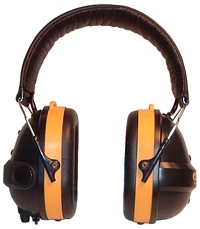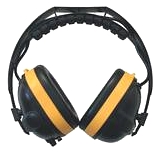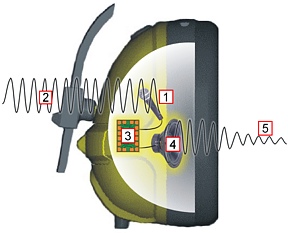Review Summary
Pro Tech Communications, Inc.
PA4000 NoiseBuster
Electronic Noise
Canceling Safety Earmuff
Priced at $149
Reviewed by Leon A. Frechette
02/26/07

Pro Tech - PA4000 electronic earmuff
I cannot stress enough the importance of consistently wearing hearing protection when working with power tools. It's every bit as important as wearing eye protection. I encourage you to make it a habit to protect both your sight and your hearing—it's the best insurance policy you can give yourself.
On that note, Pro Tech Communications contacted me about the NoiseBuster, an electronic noise canceling safety earmuff they introduced late in 2006. I have thoroughly tested it and am confident you'll also find this to be a high-quality safety product, one that is well worth the investment.
It was a surprise to open the package and discover a carrying case specifically designed for the NoiseBuster (how cool is that?), especially since the unit's retail cost is only $149. Similar products run about $200.
The NoiseBuster is mostly constructed of tough ABS plastic designed to be worn over or behind the head (only the product in the left hand photo). It weighs 17 oz. with one AA battery installed, which they claim will run the unit up to 65 hours. For use behind the head, a webbing strap headband  (included) attaches to the strap loops at the tops of the ear cups. Its hook-and-loop connections make it easily adjustable for comfortable use. (included) attaches to the strap loops at the tops of the ear cups. Its hook-and-loop connections make it easily adjustable for comfortable use.
Over the years I have tried many earmuffs, and I found this to be one of the most comfortable. The cushioned ear cups are deep, allowing the ears to lay naturally, not pressed uncomfortably, against the side of the head. I also noticed that the longer I wore the earmuffs, the tighter the seal became around my ears so they formed a great bond. Incidentally, the ear cushions are replaceable.
The unit is designed with anti-moisture features. The on/off switch is encased in a rubber boot and the audio input has a rubber cap. I found the rubber battery cover with its two thumb screws a little cumbersome to remove.
For clear crisp music while you work, connect the NoiseBuster to a CD player or portable radio through its 3.5 mm stereo input audio jack.
A slight hissing sound indicates that the unit is on, however there is an LED power indicator at the top of the power ear cup to make it easier to see that the unit is on.
What do these features mean in relationship to this unit?
The NoiseBuster Electronic Noise Canceling Safety Earmuff combines superior passive hearing protection from mid- and high-frequency noise with the most advanced electronic noise cancellation (ENC) technology to combat low-frequency noise.
Passive hearing protection is essentially a standard earmuff without electronic protection. But what are Electronic Noise Cancellation (ENC) and Active Noise Reduction (ANR)?
 To help you understand how this unit works, please check out the diagram as you read this paragraph. ENC/ANR uses a microphone inside the ear cup (1) to listen to noise coming into the ear (2). Using electronics (3), the system creates a noise wave that is a mirror image of the wave entering the ear. This "anti-noise" wave is played through a speaker (4), also located in the ear cup. When the offensive noise meets its mirror image, the noise is canceled or significantly reduced (5). To help you understand how this unit works, please check out the diagram as you read this paragraph. ENC/ANR uses a microphone inside the ear cup (1) to listen to noise coming into the ear (2). Using electronics (3), the system creates a noise wave that is a mirror image of the wave entering the ear. This "anti-noise" wave is played through a speaker (4), also located in the ear cup. When the offensive noise meets its mirror image, the noise is canceled or significantly reduced (5).
My wife has tinnitus (ringing in both ears) and wears special hearing aids that are similarly designed; a computer creates a tone in the hearing aids that mirror matches the ringing she hears. The tone cancels out the tinnitus.
Pro Tech describes ANR Protection as the most effective defense against low-frequency noise. Low-frequency noise consists of powerful sound waves that can travel great distances and cannot be absorbed by conventional passive materials. Noises generated by engines, fans, motors, and similar devices are typically dominated by low frequencies—frequencies that cannot be stopped by passive earmuffs.
In addition to detrimental effects on hearing, low-frequency noise creates another, perhaps even more serious, effect. Because low-frequency noise masks speech, it is difficult for a person to hear and comprehend speech and warning signals when exposed to such noise.
To understand how these earmuffs will help, you have to comprehend the decibel (dB) rating of sound. Think about the last time you heard a jet take off. The decibel level of a jet taking off at a distance of 2,000 feet is 110; an auto horn only 3 feet away can reach the same level. Compare them both to the normal level of human conversation, which measures 50 to 60 dB. As you can tell, hearing protection can be a big help!
However, depending on your working environment, these muffs may not be appropriate.
From a "Noise-Reduction Rating" (NRR) perspective, they have a decibel rating of 26 when worn over the head in the passive mode, which is the equivalent of a standard earmuff without the aid of electronic protection. A rating above 30 dB would be better.
Self-adjusting foam insert earplugs could have a rating between 30 and 34 dB and insert ribbed rubber plugs are around 27 dB, depending on the manufacturer. I personally find insert earplugs uncomfortable, and I'd rather not place earplugs in the ear canals. I prefer a muff because it protects the whole ear.
What does this mean? Basically, the level of noise at ear (dB) could be lowered by the NRR dB number used by the manufacturer to rate their product (noise level dB minus hearing protection NRR dB number equals noise level dB at ear). Keep in mind that hearing protection is also recommended to reduce the harmful effects of impulse noise, such as gunfire. If the NRR is based on continuous noise, it may not be an accurate indicator of the protection attainable from impulse noise.
When the 26 dB of the Passive Protection is combined with 20 dB in the Electronic Noise Cancellation (ENC) or Active Noise Reduction (ANR) mode, then you have a dynamite safety earmuff at a price that's hard to beat.
NoiseBuster is ideal for industrial workers, sports fans, and do-it-yourselfers. I recommend its use when working with power tools and even when mowing the lawn with a power mower.
The primary benefit of the NoiseBuster is how the unit protects hearing across a full range of frequencies. From a safety standpoint, critical speech communications are heard more clearly. Finally you can listen to music or a radio broadcast at lower and less damaging volume levels.
Doesn't it just make good sense to protect your hearing in noisy environments with a great pair of safety earmuffs like the NoiseBuster?
Updated 03/26/07: Just after I finished this review, I was informed that the product went through some changes. They have discontinued the product in the upper left-hand photo and replaced it with the product in the upper right-hand photo. They share the same product number but differ in only in the headband as you can see in the photos. Basically, the manufacturer has made the unit so you are not able to wear the earmuffs behind the head (which I really liked about the previous unit). The new band is made of soft cushioned vinyl—similar to that used on stereo headsets. The older headband is lot tougher in construction. I'm not sure if the newly designed headband will hold up to everyday use in construction or in the woodshop. The older version may still be available from some retailers, and it’s worth asking about.
To learn how to choose the correct hearing protection for yourself, click here!
Copyright © 02/26/07 LAF/C.R.S.,
Inc. All rights reserved.
Looking for home improvement Q&As? Click here!
[ Back to Top ]
|


